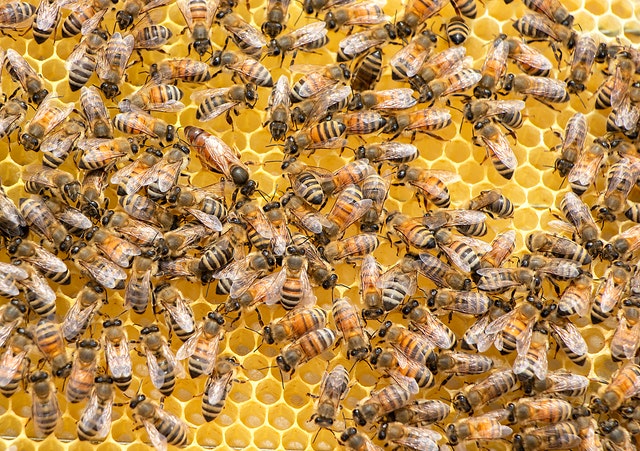Abstract
Apitherapy is a branch of alternative medicine which uses honey and other honey bee products for the treatment and prevention of cancer and various other diseases, it is well known as bee venom therapy BVT, which involves medicinal use of bee stings. Venom is thought to reduce inflammation and boost our immune system.
Here we will discuss the benefits of this therapy and how it is associated with ayurveda and how it is said to be effective in various diseases as mentioned in old age classical texts.
Introduction
Apitherapy is generally known as the therapeutic use of honeybee products including honey, beeswax and venom to treat a variety of ailments.
Bee venom is a colorless, acidic liquid which is extracted through their stingers into a target, it contains more than 40 active substances which have physiological effects and have both anti inflammatory and inflammatory compounds having antiviral, antibacterial and anticancer effects.
Bee venom also contains melittin and anti inflammatory effects which are mediated by this melittin through the inhibition of cyclooxygenase COX-2 and of the production of superoxide by neutrophils both plays major role in managing inflammation in the joints during rheumatoid arthritis.
It also has hemolytic and cytotoxic activities against human cells and needs to be modified before it can be developed safely into a drug. The most prevalent use of BVT is for the immune system and inflammatory disorders.
One of the most promising uses of BVT is to relieve the symptoms of treatment resistant MS and some studies done in the support of this treatment shows that the therapy helps in relieving fatigue and muscle spasm.


Honey, Bee Venom and Other Products
Apitherapy includes the usage of all the products created naturally from honeybees and includes following
- Bee venom: female bees produce bee venom and it can be delivered directly from a bee sting which can be administered to the skin through stainless steel micro mesh. This allows venom to enter the skin.
- Honey: one of the sweet substance produced by bees
- Propolis: this is a combination of beeswax, honey, tree resins and enzymes made by bees to protect hives from external threats like bacteria or viruses. It also possess antiviral, antifungal, antibacterial and anti-inflammatory properties as well
- Pollen: pollen contains a large no. of vitamins and nutrients.
- Royal jelly: the queen bee feeds on this enzyme enriched food containing a large amount of beneficial vitamins.
- Beeswax: it is created by honeybees to build their hive and store both honey and pollen, commonly used in cosmetic products.
These products should be used pure and in fresh form to get best results from apitherapy and vitamins found in them are used in adequate form to get effective results.
Ayurvedic View
Honey has been used from ancient times as mentioned in the old age classical texts because of its gunas (properties). Honey is described as makshika, madhu, madhvika or kshodhra in ayurveda.
Madhu is said to be yogvahi in ayurveda, yogvahi is a property in which whenever a substance is mixed with another substance it starts acting like that another substance and give rise to its properties without deterring its own. It is used in various diseases as anupana and has other properties which we will be discussing below.
Madhu (honey) is described under athe ikshu varga of anapana vidhi adhyaya (chapter) of charak samhita sutrasthana by acharya charak according to him madhu (honey) is of four types:
- Makshika: It is considered to be the best of all other types which is formed by pingal varna (copper colored) honeybees having resemblance to that of a oil.
- Bhramar: It is formed by black colored honeybees which is white in color and are considered guru (heavy) guna.
- Kshodhra: It is formed by small pingal colored honeybees and is having kapil varna.
- Pautik: large honeybees of pingal varna are called putika honey made from them is of ghrit varna (ghee colored).
Common Properties of Madhu (Honey) are as follows:
- Vatakarka (vitiating vata dosha)
- Kapha vikarnashak (kapha mitigating)
- Sandhankarka, chedana
- Ruksha (dry), kashaya (astringent), madhura (sweet) and sheeta (cold) in guna
According to bhavprakasha nighantu madhu is having eight types which includes
- MAKSHIKA is helpful in during eye related disorders, jaundice, cough and kshaya reducing
- BHRAMARJATI MADHU is guru, abhishyandi, sheeta virya and raktapitta nashak
- KSHODRA JATIYA MADHU is prameha nashaka (good for diabetes)
- PAUTIKA JATIYA MADHU is ruksha (dry), ushna (hot), vata karaka (vata vitiating) and mutrakricha nashaka
- CHATRA JATIYA is used as krimi (worms), raktapitta, prameha, moha,trishna (thirst) and visha nashaka (antitoxin) due to its sheeta (cold),guru (heavy),madhura ras guna
- AGRAYA JATIYA MADHU is useful in eye related disorders, kapha and pitta dosha mitigating having kashaya, tikta ras, katu vipaka properties
- AUDALAAKA MADHU is ruchikar (appetizer), voice modulatory,pitta karka (pitta aggravating) having kashaya, amla ras and ushna (hot) guna
- DALA JATIYA MADHU is laghu (light), agni deepak (digestive fire modulator), kaphanashaka (kapha vitiating), madhura ras yukta, snigdha,ras-raktaadi vardhaka.
Properties of New and Old Madhu
Madhu (honey) is said to be old if it is made a year ago and new when it is made within a year.
- Old madhu properties- grahi, ruksha (dry), lekhana guna pradhana and meda nashaka (fat reducing)
- New madhu properties- pushtikar, kapha nashaka (kapha mitigating) and saraka guna pradhan
Ushna madhu (heated honey) is said to be fatal in general and also to the ushanta pidita person in ayurveda because honeybees are poisonous and collects honey from the toxic flowers too which raises the toxicity when consumed by the ushanta pidita person.
Madhu should be used in adequate amount because it may lead to the development of ama dosha in body when taken in excess quantity called madhvama (madhu sevanajanya amaajirna) it is considered to be fatal same as that of poison cause it is considered to be chikitsa virodhi as in general ushna chikitsa is done in ama ajeerna but this chikitsa is considered viprit in madhvama roga which is very dangerous and fatal.
So, sheetla madhu is considered to be gunkari instead of ushna to avoid its fatality.
Benefits of Bee Venom
Bee venom is effective in the treatment of disorders like
- Immune system problems such as arthritis and multiple sclerosis
- Cardiovascular disease such as hypertension, atherosclerosis, arrhythmias and varicose veins.
- Endocrine disorders such as menstrual cramps, irregular periods decreased blood glucose levels
- Psychological disturbances like depression or mood swings
- Skin conditions such as eczema, psoriasis, corn and topical ulcers
- Rheumatological disturbances like osteoarthritis, bursitis and tennis elbow.
For treatment, a bee is taken from a hive with a pair of tweezers and held on the body part to be stung. The stinger is left in for 10 to 15 minutes. The frequency of sessions varies and no. of stings delivered depends on the patient’s tolerance and nature of the disease.
Treating chronic problems like arthritis can take several stings per session two to three times per week for three months. Injections are also administered the same way depending upon the condition of the ailment to be treated where live bees are not used instead venom is used in injectable form under the skin.
Preparations
Before the beginning of the therapy, a test dose is given where a doctor will inject the patient with a weak form of the venom to test for allergic reaction.
Meanwhile a syringe of epinephrine is placed nearby if any allergic reaction occurs epinephrine is used and the therapy is not administered. The allergic reaction generally occurs in 15 to 20 minutes.ice may be used to numb the area where sting will occur. It can also be used afterward to soothe pain.
Side Effects
Pain, swelling and itching are common at the injection site. Patients should be warned about the severe anaphylactic reactions leading to respiratory, cardiac problems and death may also occur. Out of all itching is reported in most of the patients.
Conclusion
Apitherapy generally describes the usage of all the products coming directly from honeybees. Though it is useful in various diseases as in BVT (bee venom therapy) directly in sting form or injectable form, it also has some side effects like allergic or anaphylactic reaction which will lead to some complications.
The therapy should be done by a trained doctor or practitioner and the usage of honey should be done in adequate amounts to avoid its fatality as mentioned above in its ayurvedic view.
Apiculture is considered to be a part of ayurveda as some of its forms are mentioned in the old classical texts where its properties are mentioned in as anupama madhu (honey) is used in various diseases like kasa, swasa, prameha and raktapitta.
It is also used in panchkarma for the preparation of basti dravya where madhu is used along with ghee to form various bastis like asthapana vasti (mustadi vasti, vrishya basti etc.) In case of any query kindly visit www.planetAyurveda.com.



